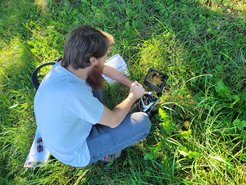Tower power
Living worm towers are recorded in the wild for the first time, a rare example of collective hitchhiking in nature

- First evidence of “living towers” in nature: observed in rotting apples and pears from local orchards in Konstanz, Germany
- Tower function confirmed: towers can attach to passing insects and can bridge physical gaps to disperse
- A powerful model: C. elegans are a new a tool for studying the ecology and evolution of collective dispersal
Nematodes are the most abundant animal on earth, but when times get tough, these tiny worms have a hard time moving up and out. So, they play to the strength of their clade. If food runs out and competition turns fierce, they slither towards their numerous kin. They climb onto each other and over one another until their bodies forge a living tower that twists skyward where they might hitch a ride on a passing animal to greener and roomier pastures.
At least that’s what scientists assumed. For decades, these worm structures were more mythical than material. Such aggregations, in which animals link bodies for group movement, are rare in nature. Only slime molds, fire ants, and spider mites are known to move in this way. For nematodes, nobody had even seen the aggregations—known as towers— forming anywhere but within the artificial confines of laboratories and growth chambers; and nobody really knew what they were for. Did towers even exist in the real world?
Now, researchers in Konstanz, Germany, have recorded video footage of worms towering in fallen apples and pears from local orchards. The team from the Max Planck Institute of Animal Behavior (MPI-AB) and the University of Konstanz combined fieldwork with laboratory experiments to provide the first direct evidence that towering behavior occurs naturally and functions as a means of collective transport.
“Living towers” of nematode worms recorded in the wild for the first time
“I was ecstatic when I saw these natural towers for the first time,” says senior author Serena Ding, group leader at the MPI-AB, of the moment when co-author Ryan Greenway sent her a video recording from the field. “For so long natural worm towers existed only in our imaginations. But with the right equipment and lots of curiosity, we found them hiding in plain sight.”

Greenway, a technical assistant at the MPI-AB, spent months with a digital microscope combing through decaying fruit in orchards near the university to record natural occurrences and behavior of worm towers. Some of these whole towers were brought into the lab. What was inside the towers surprised the team. Although the fruits were crawling with many species of nematodes, natural towers were made only of a single species, all at the tough larval stage known as a “dauer.”
“A nematode tower is not just a pile of worms,” says the first author Daniela Perez, a postdoctoral researcher at MPI-AB. “It’s a coordinated structure, a superorganism in motion.”
The team observed the natural dauer towers waving in unison, much like individual nematodes do by standing on their tails to latch onto a passing animal. But their new findings showed that entire worm towers could respond to touch, detach from surfaces, and collectively attach to insects such as fruit flies—hitchhiking on mass to new environments.
To probe deeper, Perez built a controlled tower using laboratory cultures of C. elegans. When placed on food-free agar with a small vertical post—a toothbrush bristle—hungry worms began to self-assemble. Within two hours, living towers emerged, stable for over 12 hours, and capable of extending exploratory “arms” into surrounding space. Some even formed bridges across gaps to reach new surfaces.
“The towers are actively sensing and growing,” says Perez. “When we touched them, they responded immediately, growing toward the stimulus and attaching to it.”
This behavior, it turns out, is not restricted to the so-called “dauer” larval stage seen from the wild samples. Adult C. elegans and all larval stages in the lab also towered—an unexpected twist that suggests towering may be a more generalized strategy for group movement than previously assumed.
Yet despite the architectural complexity of these towers, the worms inside showed no obvious role differentiation. Individuals from the base and the apex were equally mobile, fertile, and strong, hinting at a form of egalitarian cooperation. But so far only, the authors point out, in the controlled conditions of the laboratory. “C. elegans is a clonal culture and so it makes sense that there is no differentiation within the tower. In natural towers, we might see separate genetic compositions and roles, which prompts fascinating questions about who cooperates and who cheats.”
As researchers seek to understand how group behavior evolves—from insect swarms to bird migrations—these microscopic worm towers might rise to provide some of the answers.
“Our study opens up a whole new system for exploring how and why animals move together,” says Ding who leads a research program on nematode behavior and genetics. “By harnessing the genetic tools available for C. elegans, we now have a powerful model to study the ecology and evolution of collective dispersal.”













